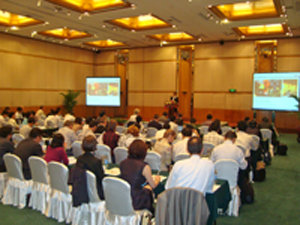The 2nd International Conference on Flame Retardants in Guanghzou, China

The Second International Conference on Flame Retardants: Chinese and International Markets, Requirements, Challenges and Innovations organized by the SINO-German Plastic Technology Service (Cheng De) Co., Ltd. and chaired by Dr. Troitzsch Fire and Environment Protection Service FEPS took place in Guangzhou on 15 and 16 May 2011 (programme, see attachment). Around 80 delegates and speakers discussed and presented drivers for new developments in fire safety, flame retardants (FRs), and advanced applications in the key technologies of building and construction, transportation, electrical engineering and electronics (E&E) sectors.
The first part of the conference dealt with regulations, tests and evolving markets. In a series of papers, first, developments and trends in fire safety regulations and testing in European construction and railways, international transportation (cars, busses, ships) and E&E, as well as the role of new product development in these fields were addressed. Overviews on new challenges and innovations for the fire safety of electrical cars (lithium batteries and safety relevant plastic parts) as well as on green design in electronics as perceived by Original Equipment Manufacturers (OEMs) showed the trends for the future.
The second part covered new developments in flame retarded (FR) plastics and innovations in FRs with presentations on established and new FR systems in engineering plastics, on challenges for FR compounds in the light of the current shortage of many FRs, particularly in China. Thermoplastic polyurethanes (TPUs) and the potential markets of halogenfree FR grades, particularly in automotive e-mobility, are interesting new developments. This also applies to halogenfree FR thermoplastic elastomers (TPEs), which may replace PVC in specific automotive E&E applications. The halogenfree FRs developed here act in the gas phase and are therefore very effective.
The challenges of miniaturization, high fire safety levels and environmentally conscious design in E&E were addressed. They have led to the development of new FR systems, for example of brominated polymeric FRs. Another presentation highlighted the environmental properties of this brominated FR family and the evolving sustainability debate between halogenated and non-halogenated FR systems.
Papers on intumescent systems for UL 94-V0 polypropylene grades with low smoke development based on phosphorous / nitrogen FR systems and an overview on the stability of red phosphorus formulations in polyamides showed the innovations and developments in these fields.
Finally, contributions on the role of inorganic FRs, such as new grades of aluminium and magnesium hydrates, the role of boehmite as a synergist in formulations with metal phosphinates in engineering plastics, and Si- and P-containing glasses and their synergy with organoclays as promising additives for thermosets revealed new interesting fire safety approaches for a family of FRs seen until now as of low efficiency and limited applications.
The Third International Flame Retardants Conference will take place just before the next Chinaplas in Shanghai on 16 and 17 April 2012.